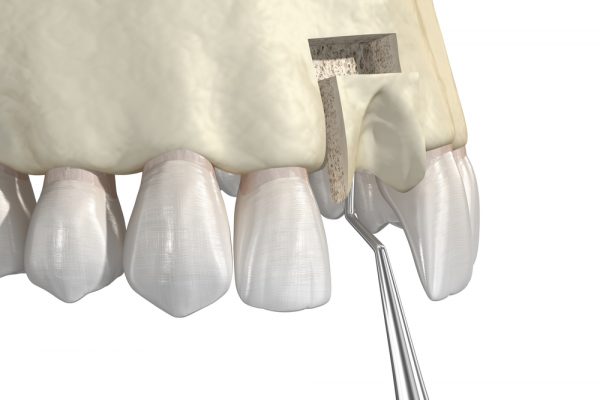Restoring Your Jawbone For Implant Success
Dental implants can be a life-changing restorative procedure, but if you’ve experienced extensive resorption (loss of bone) in your jaw, then you might be disqualified. Fortunately, at Zajac Dental, Oakville, ON, implant dentist Dr. Pawel Zajac and our team understand the importance of a strong foundation for a healthy smile.
Dental bone grafting is a specialized procedure that can restore and regenerate the jawbone, providing a solid base for dental implants or other restorative treatments. In this article, we will explore the process, benefits, aftercare, and frequently asked questions about dental bone grafting. Discover how this procedure can help you regain a confident and functional smile.
What is Dental Bone Grafting?
Dental bone grafting is a surgical procedure that involves the transplantation or augmentation of bone material to the jawbone. This procedure is commonly performed to address bone loss or deficiencies resulting from tooth extraction, periodontal disease, trauma, or other factors. The grafting material stimulates the growth of new bone cells, enhancing the jawbone’s strength and volume.
Benefits of Dental Bone Grafting
Dental bone grafting can have numerous benefits both functionally and aesthetically. Some of the many benefits of dental bone grafting include the following:
- Restoration of Jawbone Structure: Dental bone grafting is an effective solution for restoring the integrity and volume of the jawbone. By adding grafting material to the deficient areas, the procedure promotes the growth of new bone cells, creating a strong foundation for dental implants or other restorative treatments.
- Improved Dental Implant Success: Dental implants require a stable and healthy jawbone for successful placement and long-term stability. By undergoing a bone grafting procedure, patients with insufficient jawbone structure can increase their chances of a successful dental implant outcome.
- Preservation of Facial Aesthetics: Jawbone loss can lead to a sunken or collapsed appearance of the face, which can age the overall facial structure. Dental bone grafting helps to preserve the natural contours of the face by rebuilding the jawbone, resulting in a more youthful and aesthetically pleasing appearance.
- Enhanced Chewing Function: A strong jawbone is essential for proper chewing and biting function. Dental bone grafting restores the integrity of the jawbone, allowing patients to enjoy a balanced and efficient chewing function, and improving their ability to eat a variety of foods.
- Long-Term Oral Health: Dental bone grafting not only improves the function and aesthetics of the smile but also contributes to long-term oral health. By restoring the jawbone, the procedure provides support for the surrounding teeth, preventing further bone loss and maintaining overall dental health.




Types of Dental Bone Grafts
Several types of dental bone grafts can be used based on individual needs and circumstances. The choice of grafting material depends on factors such as the extent of bone loss, the location of the graft, and the patient’s overall oral health. Here are some common types of dental bone grafts:
Autograft
An autograft involves using the patient’s bone as the grafting material. The bone is typically taken from another area of the body, such as the chin, jaw, or hip. Autografts are advantageous because they have a high success rate and minimize the risk of rejection or infection. However, an additional surgical site is required to harvest the bone.
Allograft
Allografts utilize bone grafting material obtained from a donor source, which is thoroughly processed and sterilized to ensure safety. This type of graft eliminates the need for a second surgical site for bone harvesting and is readily available. Allografts are safe, effective, and commonly used in dental bone grafting procedures.
Xenograft
Xenografts involve using bone grafting material derived from an animal source, typically bovine or porcine. The animal bone is processed to remove all organic components, leaving behind the mineral structure. Xenografts serve as a scaffold for new bone formation and eventually get replaced by your own bone matter.
Alloplastic Materials
Alloplastic bone grafts utilize synthetic materials, such as calcium phosphate or hydroxyapatite, as the grafting material. These materials are biocompatible and provide support for new bone growth. Alloplastic grafts eliminate the need for a secondary surgical site and offer a predictable outcome.
Composite Grafts
Composite grafts involve a combination of different grafting materials. For example, a composite graft may include a mixture of autograft, allograft, or alloplastic materials to take advantage of their individual properties. Composite grafts are tailored to the specific needs of the patient and offer flexibility in addressing complex bone loss situations.
The choice of dental bone grafting material is determined through thorough evaluation and discussion with your Oakville, ON implant dentist, Dr. Zajac. He will consider factors such as the volume and quality of existing bone, the specific treatment goals, and your overall oral health to determine the most suitable grafting option for your needs.
Dental Bone Grafting Process
Consultation
During the initial consultation, our experienced Oakville implant dentist will evaluate your oral health and determine if dental bone grafting is the appropriate solution for your needs. We will discuss the procedure in detail, address any concerns or questions you may have, and create a personalized treatment plan. If you’re feeling nervous, we can provide sedation dentistry options that can be applied before your procedure.
Grafting Procedure
The bone grafting procedure is typically performed under local anesthesia to ensure your comfort. The grafting material, which can come from your own bone, a donor source, or synthetic materials, is carefully placed in the targeted areas of the jawbone. Over time, the graft will integrate with the existing bone and stimulate the growth of new bone cells.
Healing and Integration
Following the procedure, a period of healing is necessary for the graft to integrate with the jawbone. During this time, it is crucial to follow the aftercare instructions provided by our dental team. This may include pain management, oral hygiene practices, and dietary restrictions to promote optimal healing and success.
Implant Placement
Once the jawbone has fully healed and the graft has successfully integrated, dental implants can be placed. The newly strengthened jawbone provides a secure foundation for the implant, increasing the likelihood of successful implantation and long-term stability.


Frequently Asked Questions
Is dental bone grafting a painful procedure?
How long does it take for the bone graft to heal?
Can anyone undergo dental bone grafting?
Are there any risks associated with dental bone grafting?
Call Zajac Dental For A Stronger Jawbone & Implant Success!
By choosing dental bone grafting at Zajac Dental you can restore the strength and volume of your jawbone, paving the way for a confident and functional smile. To learn more about the many benefits and costs of dental bone grafting, contact our Oakville, ON, dental office by dialing (905) 901-3824 or filling out our convenient online contact form. We warmly welcome patients in Oakville and surrounding areas such as Flagarwood, Holton Heights, Sunningdale, and West Oak Trails, ON. We look forward to helping you achieve your dream smile.